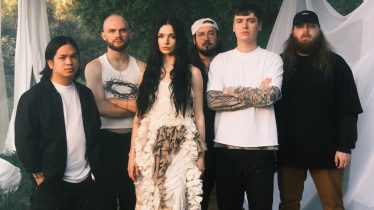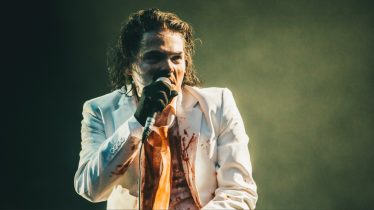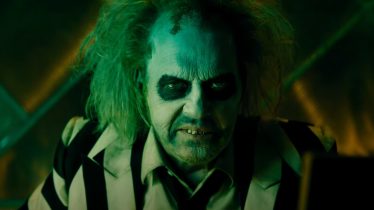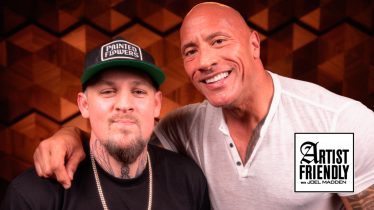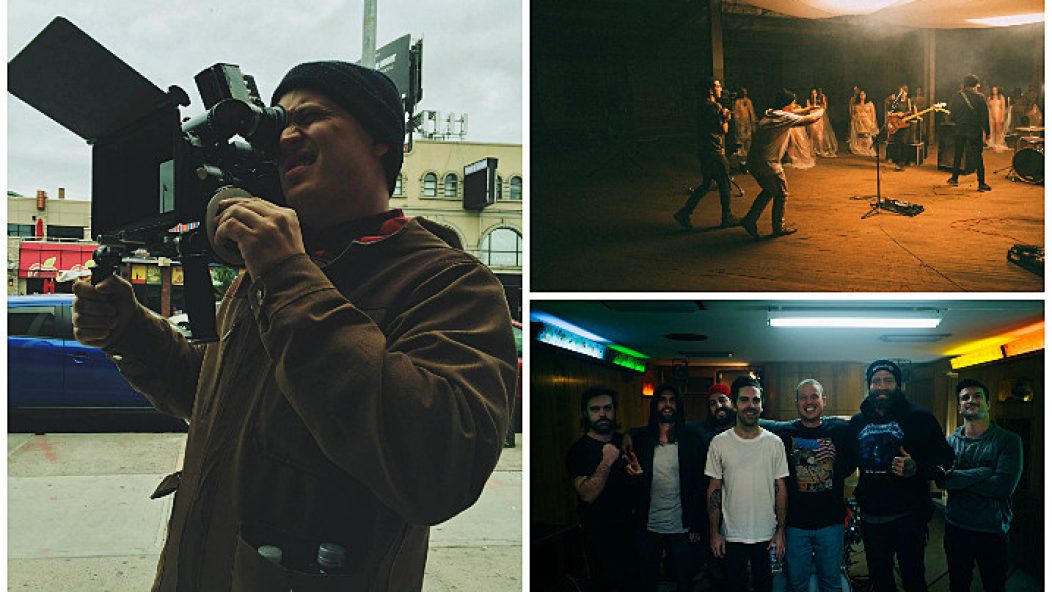
Kyle Thrash has created videos for the scene’s heaviest hitters, here’s how he got where he is
Kyle Thrash stumbled his way through high school in rural Pennsylvania and fell into a video production program at Drexel University. It was there that he finally found a sense of purpose and a knack for creation through trial and error and chasing the rush of out-of-bounds filmmaking. Now he’s made music videos for the likes of Four Year Strong, Real Friends and Microwave and been nominated for APMAs for his work with Modern Baseball and State Champs, while continuing to produce commercials for big brands like Levis. Griffin Elliot caught up with Thrash in a noisy bar in Brooklyn in late February, as he was fresh off a long shoot for a new Every Time I Die video.
How’d you get into video producing?
I went to school at Drexel University in Philly and started making videos there. I went to film school not knowing what I wanted to do. I liked movies and I was making skateboarding and Jackass videos. I went because it was the only thing I liked to do and I thought I was good at it, then I started making videos for my friend’s bands and it took off from there. I didn’t just want to get into music videos, and I don’t want to just do music videos, it’s just where I’m at right now, but I like it. It’s stressful but incredibly rewarding.
Was there a point when you were like, “Damn, I am good at this and I wouldn’t mind doing it forever,” or was it more of a natural progression?
There was a point sophomore year of college; I made this documentary called John The John. My buddy and me went down to Chinatown and we [hid] a small camera in a backpack and tried to get a handjob from massage parlors, and see if they would offer us sex. That rush was amazing and I got an A+ on the project. Like I said, I grew up loving Jackass and skating, and I loved punk music, I love counterculture, I like underground shit, I like art that people are doing that’s not mainstream. When that happened, I was like, “Whoa, I can get a rush from going into these places and being scared and having that feeling”—that made me think that I like this. Eventually my buddy got a handjob from 50-year-old woman, it was crazy. It was this really weird project that was super-punk and definitely illegal, but it felt exciting. We talked to the DA about how these places can operate and we talked about people that deal with abuse, it was a really cool project and I was like, “Okay, I can do this on my own.”

[Photo Credit: Emily Dubin]
When did handjobs turn into music videos?
The first video I did for a proper artist was this hip-hop producer called RJD2, he did the Mad Men theme song, and he’s done a lot of other cool stuff. He was doing this project super cheap with a music producer at Drexel and they were looking for directors, then suddenly I was doing this video for RJD2, who’s an amazing artist. And that video turned out really well; he loved it and it got my foot in the door.
Tell us about the recent Every Time I Die shoot you did.
The video is about Western New York in the wintertime. We did it for the song called “Map Change” and we shot for nine days, which is the longest I’ve ever shot for a music video. It’s half documentary-based and half narrative-based. Basically, we wanted to show a bunch of different professions in the wintertime and how they get affected. Also, how in the wintertime it sometimes feels like people are going crazy and it kinda feels like the world is dying. So we wanted to show the extremes of that, like violence and drug use and people working through the snow. We shot a lot with real people, we shot with a fire department, we shot with mailmen, we shot with a high school wrestling team, we shot with truck drivers—and because we didn’t have a ton of money, we were literally knocking on truckers’ doors at truck stops. There’s that exploration that, again, is just amazing; it’s literally just us with a camera being like, “What can we go find?” We knocked on the firehouse door and were like, “Can we see what’s going on?” And then we’re watching them suit up and get ready to rock for a fire. It’s getting that access that a normal person doesn’t have, it’s amazing.
We shot all these different things—some of it was with actors, some with just normal people—and we make this collage of sorts, where it just feels like my representation of winter in Buffalo. I’m really excited about it. We broke into abandoned churches, we shot in abandoned trailers and we had the cops called on us five times. We’d have fights in public just to see how people react. We had these sugar breakaway bottles that look exactly like beer bottles, but they don’t hurt if you get hit over the head, and we shot at this one bar—we just asked the bartender he was cool with it and the bouncer was fine with it, but no one else knew. So we did this fight scene and people jumped in; it’s just wild the way people react. It’s real.
We were on our way to Rochester and we saw these two drunk guys on scooters and we just started filming them, and one of them was so drunk he fell over. It’s just this amazing moment where he’s super angry and kicking the ground, and the other one comes at us, trying to hit us with his cane, and it’s just this real moment of humanity.

[Photo Credit: Justin Derry]
So when you’re tackling a project like that, how big is your team and at what point does your role stop?
It’s four people: me, the director; a producer who does all the groundwork in terms of calling places, finding locations, talking to a ton of different people; and then the director of photography (DP) who’s the cinematographer and does all the shooting. Then I’ll have an editor who will take everything and put it all together. On [the ETID shoot], the smaller the crew the better, and certain times even I had to hang back. There was this cat lady and we knocked on her door and were like, “Can we come see your trailer?” And she was like, “You’re not gonna rob me, right?” She was just scared, so I hung back in the van and my DP got these amazing shots of cats all over this trailer. Eating things and hanging out in the sink, and we got this great portrait of her with all these cats. On that type of thing, you don’t want too many people. To get into their world it’s better to be a small team.
What do you do on a day-to-day basis? What’s your workweek look like?
You caught me at a good time for this story because I’m in the middle of a ton of different videos. Next Monday I start on a five-day video for Sorority Noise; I’m doing a video for the song “No Halo.” I’m really excited for that video, so we’re doing all the prep for that—all the location scouting and casting. We basically started on that this week and locked in all the creative today.

[Photo Credit: Brett Sweeney]
You were saying music videos weren’t really what you were aiming to do. Where would you like to go with this?
It’s one thing at a time, that’s how I look at it. I used to have this mentality where if I’m not always working toward a specific goal I feel disappointed, so I try not to let expectations make me disappointed. I don’t want expectations to deflate me in any way. For me it’s commercials, that’s the next step. That’s been more money, whether it’s Levis or other brands I’ve been doing work for, that since I’ve been repped I can pitch on. I work with a production company called More Media, they signed me last year, and basically they get me things I can’t get on my own. I can get Every Time I Die on my own, I can get Microwave, and what we’re doing with Every Time I Die is what we did with the Microwave video. That video is also half-and-half: We saw someone smoke crack, that was real. Then we also had a guy huffing paint, that wasn’t real. We blur the lines. I don’t know a ton of people who are doing that type of work, which is like pseudo-documentary stuff because what you want to believe is real, is real. So what you see, what I’m telling you is real, is real to you.

